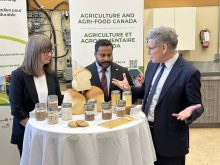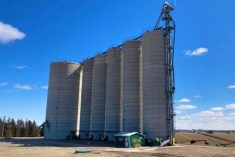Farmers planning to try Engage Agro’s new plant growth regulator, Manipulator, this year will first want to call their grain buyers.
Many Prairie farmers recently received letters from Winnipeg grain firm Parrish and Heimbecker, for example, stating P+H will not buy wheat treated with Manipulator this season.
“We completely understand why a lot of the grain companies are taking that stance,” said Tom Tregunno, product manager for Engage Agro in Kitchener, Ont.
Manipulator has been fully registered since last year for use in Canada — but in the U.S., there’s no established maximum residue limit (MRL) yet for the product. Any residue at all found in a wheat shipment could lead an end-user to reject the shipment entirely.
Read Also

U.S. livestock: CME cattle tick lower in thin pre-holiday trade
Chicago | Reuters – Chicago Mercantile Exchange live and feeder cattle futures were little changed but ended slightly lower on…
Wheat treated with Manipulator thus can’t be exported into the U.S. until the issue is resolved.
“We’re working really quickly to try to get (the MRL) established as soon as possible,” Tregunno said.
Some grain buyers who plan to sell wheat into markets where there’s an established MRL for Manipulator have indicated they will buy grain treated with the product. Others will not.
For this growing season, Engage Agro has made sure retailers handling Manipulator know there may be buyer concerns. “We allowed people to take product back,” Tregunno said.
Plant growth regulators
Manipulator (chlormequat chloride) is fully registered in Canada for use on spring and winter wheat.
When concerns about MRLs for export into the U.S. first came to light, Tregunno said, “it was a bit of a shock to us. The product’s been in use for so long in Europe.”
Plant growth regulators alter plant growth, slowing stem growth to prevent lodging in high-yielding crops. While they’re common in other parts of the world, growth regulators have not been commonly used in Western Canada, where we normally have drier weather and grow varieties with good lodging resistance.
However, as crop genetics improve and farmers push for ever-higher yields, many growers are looking at including plant growth regulators as part of their crop input package.
“It works really well,” Tregunno said of Manipulator. “It’s really visual. Agronomists really like it because they can play with their fertility level.”
The future
While Manipulator’s MRL issue will eventually be resolved, Cam Dahl, president of Cereals Canada, said he sees the matter as an example of “a much broader issue.”
Buyers’ ability to test residue levels on exported crops has increased — and, Dahl said, “there’s a lot more attention being paid to issues around crop input and residue concerns.”
While Manipulator is the focus today, “this isn’t just one product,” he said.
Not all countries approve crop input products at the same time. When there is a discrepancy, Canadian exporters must respect regulations in key markets to maintain access to markets and their reputation for safety and quality.
It’s also important for farmers to make sure to follow labels carefully, to keep residue limits on their grain below the maximum accepted levels.
“We’re going to need to have a broader conversation with producers about this,” Dahl said. “And it’s not just focused on producers. We do need to have those conversations inside the entire value chain… That’s one of the things that Cereals Canada was created to do.”
— Leeann Minogue is the editor of Grainews at Griffin, Sask. Follow her at @GrainMuse on Twitter.
















